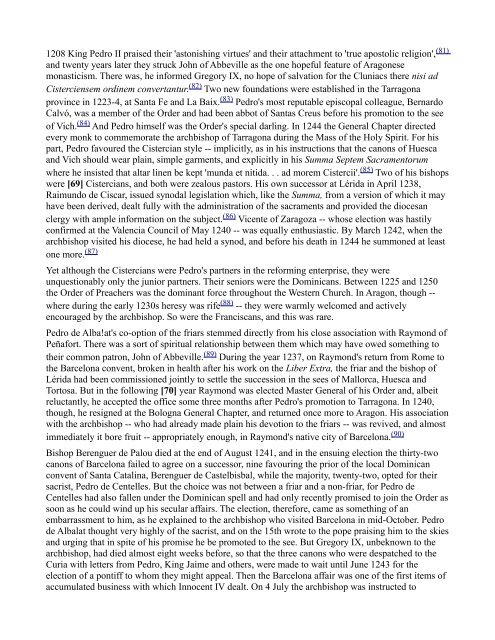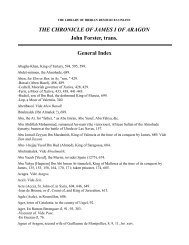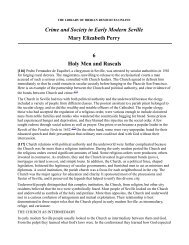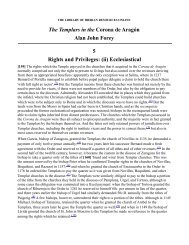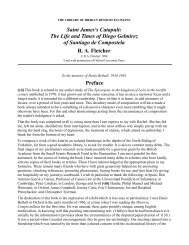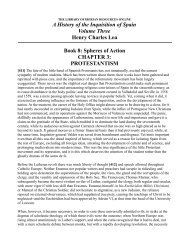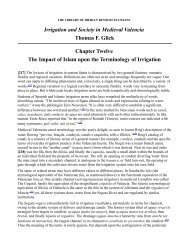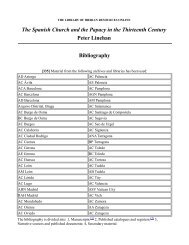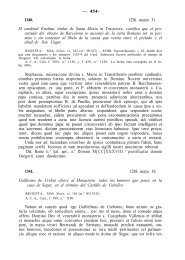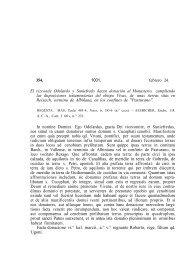Chapter 4 - The Library of Iberian Resources Online
Chapter 4 - The Library of Iberian Resources Online
Chapter 4 - The Library of Iberian Resources Online
Create successful ePaper yourself
Turn your PDF publications into a flip-book with our unique Google optimized e-Paper software.
1208 King Pedro II praised their 'astonishing virtues' and their attachment to 'true apostolic religion', (81)<br />
and twenty years later they struck John <strong>of</strong> Abbeville as the one hopeful feature <strong>of</strong> Aragonese<br />
monasticism. <strong>The</strong>re was, he informed Gregory IX, no hope <strong>of</strong> salvation for the Cluniacs there nisi ad<br />
Cisterciensem ordinem convertantur. (82) Two new foundations were established in the Tarragona<br />
province in 1223-4, at Santa Fe and La Baix. (83) Pedro's most reputable episcopal colleague, Bernardo<br />
Calvó, was a member <strong>of</strong> the Order and had been abbot <strong>of</strong> Santas Creus before his promotion to the see<br />
<strong>of</strong> Vich. (84) And Pedro himself was the Order's special darling. In 1244 the General <strong>Chapter</strong> directed<br />
every monk to commemorate the archbishop <strong>of</strong> Tarragona during the Mass <strong>of</strong> the Holy Spirit. For his<br />
part, Pedro favoured the Cistercian style -- implicitly, as in his instructions that the canons <strong>of</strong> Huesca<br />
and Vich should wear plain, simple garments, and explicitly in his Summa Septem Sacramentorum<br />
where he insisted that altar linen be kept 'munda et nitida. . . ad morem Cistercii'. (85) Two <strong>of</strong> his bishops<br />
were [69] Cistercians, and both were zealous pastors. His own successor at Lérida in April 1238,<br />
Raimundo de Ciscar, issued synodal legislation which, like the Summa, from a version <strong>of</strong> which it may<br />
have been derived, dealt fully with the administration <strong>of</strong> the sacraments and provided the diocesan<br />
clergy with ample information on the subject. (86) Vicente <strong>of</strong> Zaragoza -- whose election was hastily<br />
confirmed at the Valencia Council <strong>of</strong> May 1240 -- was equally enthusiastic. By March 1242, when the<br />
archbishop visited his diocese, he had held a synod, and before his death in 1244 he summoned at least<br />
one more. (87)<br />
Yet although the Cistercians were Pedro's partners in the reforming enterprise, they were<br />
unquestionably only the junior partners. <strong>The</strong>ir seniors were the Dominicans. Between 1225 and 1250<br />
the Order <strong>of</strong> Preachers was the dominant force throughout the Western Church. In Aragon, though --<br />
where during the early 1230s heresy was rife (88) -- they were warmly welcomed and actively<br />
encouraged by the archbishop. So were the Franciscans, and this was rare.<br />
Pedro de Alba!at's co-option <strong>of</strong> the friars stemmed directly from his close association with Raymond <strong>of</strong><br />
Peñafort. <strong>The</strong>re was a sort <strong>of</strong> spiritual relationship between them which may have owed something to<br />
their common patron, John <strong>of</strong> Abbeville. (89) During the year 1237, on Raymond's return from Rome to<br />
the Barcelona convent, broken in health after his work on the Liber Extra, the friar and the bishop <strong>of</strong><br />
Lérida had been commissioned jointly to settle the succession in the sees <strong>of</strong> Mallorca, Huesca and<br />
Tortosa. But in the following [70] year Raymond was elected Master General <strong>of</strong> his Order and, albeit<br />
reluctantly, he accepted the <strong>of</strong>fice some three months after Pedro's promotion to Tarragona. In 1240,<br />
though, he resigned at the Bologna General <strong>Chapter</strong>, and returned once more to Aragon. His association<br />
with the archbishop -- who had already made plain his devotion to the friars -- was revived, and almost<br />
immediately it bore fruit -- appropriately enough, in Raymond's native city <strong>of</strong> Barcelona. (90)<br />
Bishop Berenguer de Palou died at the end <strong>of</strong> August 1241, and in the ensuing election the thirty-two<br />
canons <strong>of</strong> Barcelona failed to agree on a successor, nine favouring the prior <strong>of</strong> the local Dominican<br />
convent <strong>of</strong> Santa Catalina, Berenguer de Castelbisbal, while the majority, twenty-two, opted for their<br />
sacrist, Pedro de Centelles. But the choice was not between a friar and a non-friar, for Pedro de<br />
Centelles had also fallen under the Dominican spell and had only recently promised to join the Order as<br />
soon as he could wind up his secular affairs. <strong>The</strong> election, therefore, came as something <strong>of</strong> an<br />
embarrassment to him, as he explained to the archbishop who visited Barcelona in mid-October. Pedro<br />
de Albalat thought very highly <strong>of</strong> the sacrist, and on the 15th wrote to the pope praising him to the skies<br />
and urging that in spite <strong>of</strong> his promise he be promoted to the see. But Gregory IX, unbeknown to the<br />
archbishop, had died almost eight weeks before, so that the three canons who were despatched to the<br />
Curia with letters from Pedro, King Jaime and others, were made to wait until June 1243 for the<br />
election <strong>of</strong> a pontiff to whom they might appeal. <strong>The</strong>n the Barcelona affair was one <strong>of</strong> the first items <strong>of</strong><br />
accumulated business with which Innocent IV dealt. On 4 July the archbishop was instructed to


